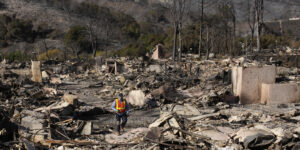As Hurricane Harvey poured on Houston, Frank Rodriguez feared for his 2014 GMC Sierra. Once he saw the pickup’s soaking-wet interior and center console full of water, he knew it was a lost cause. He just hoped his insurance company would agree and cut him a check.
Despite a dearth of inspectors in southern Texas to review the damage in person, those funds came through. The insurer took Rodriguez’s word the truck was totaled and approved his claim over the phone, he said, and about three weeks later, his truck’s lien was paid off, he had a check in hand and he was one of thousands in the region back in the market for a new vehicle.
“They gave me a really fair market value for it,” said Rodriguez, 32. “They took care of me. I thought it was going to be a more stressful procedure.”
Drivers needing replacement vehicles in Hurricane Harvey’s aftermath could help September go down as one of the best U.S. sales months this year. Although the annualized rate is still seen slipping compared to last year’s blistering pace, the decline is expected to be less pronounced after as many as a million autos were lost or damaged in the late summer storm — plus more in Irma and Maria that analysts say won’t show up in replacement demand for at least another month.
“When you have hundreds of thousands of people affected by an event of this magnitude,” said Edmunds analyst Jessica Caldwell, “not everyone will hit the market at once.”
September Pace
When automakers report monthly U.S. vehicle sales on Tuesday, they’ll probably show an annualized pace of light-vehicle sales of 17.4 million in September, according to a Bloomberg News survey of analysts. The projected rate, which is adjusted for seasonal trends, would be down from 17.7 million a year earlier but would still mark the best pace since February.
Toyota Motor Corp. and General Motors Co. are seen posting some the largest gains among the biggest suppliers to the U.S. market, while Fiat Chrysler Automobiles NV and Nissan Motor Co. could see hefty declines, according to analyst forecasts.
Honda Motor Co., which analysts expect to see a slight uptick in sales, has been busy in Texas as drivers quickly work to replace Harvey-damaged rides, said Ray Mikiciuk, assistant vice president of Honda sales in the U.S. Not everyone waits even a few weeks for an insurance check, he said, since some have the means to replace a lost vehicle immediately and others have such a pressing need that they simply can’t delay. Honda hasn’t yet seen much of an Irma bounce, he added.
Insurance companies have been busy doing their part to return hurricane victims’ lives to normalcy fast. State Farm sent more than 1,000 people to affected areas, spokeswoman Rachael Risinger said by email. The company, which has received almost 37,000 auto claims in Texas alone, has paid out more than $345 million to car owners impacted by Harvey, it said Friday in an email. It’s paid out only about $35 million to auto customers impacted by Irma, which made landfall in Florida about two weeks later.
Regional Split
That difference is reflected in September’s regional sales. The South Central region, which includes Houston, was up 14 percent through Sept. 24 as drivers replaced cars, while the Southeast region that includes Florida was down 16 percent, according to J.D. Power.
Replacement demand for cars destroyed in the year’s three big storms will likely trickle all the way into 2019, especially for drivers less lucky than Rodriguez who are struggling to convince their insurance companies to pay for an all-out replacement.
“Of course, if it’s flooded with water, upside down, it’s easy to make the case,” Henner Lehne, a senior director in the global vehicle group at IHS Markit, told reporters last week in a briefing in suburban Detroit. “But there will be definitely various corner cases where the question is: ‘Is that a complete, total damage or is it still repairable?'”
New Wheels
Although IHS Markit estimates that about 500,000 new vehicles will be demanded to replace what Harvey destroyed, the researcher last month cut its full-year industry sales projection to 17 million, Lehne said. Its estimate this spring was for almost 17.4 million.
As for Rodriguez, who studies mechanical engineering technology at the University of Houston, he was happy with his truck and hasn’t been looking to upgrade to a new vehicle before the storm hit. But now he’s shopping around. He’s looking at some new models at the GMC dealership where he bought his pickup, but with trucks at a premium in Houston — spurred by high demand from contractors — he’s open to a car, like the 2017 Toyota Camry he drove for two weeks as a rental.
Or he might head out of town. He’s read on an online forum about a St. Louis dealership that will pick up flood victims at the airport and sell them a vehicle for $2,500 to $3,000 less than he would pay in Houston. That kind of savings would more than cover the cost of his trip.
“Getting away for the weekend,” he said, “wouldn’t be so bad.”
–With assistance from Sonali Basak and John Lippert.





















 Property/Casualty Insurance in the Era of Rising Complexity
Property/Casualty Insurance in the Era of Rising Complexity  Future of Jobs: Claims Adjuster Among Fastest Declining Professions
Future of Jobs: Claims Adjuster Among Fastest Declining Professions  Southern California Wildfires Spark Interest in Natural Building Materials
Southern California Wildfires Spark Interest in Natural Building Materials  Handwritten Ad to Inc. 5000: ReSource Pro CEO Talks Growth, Change
Handwritten Ad to Inc. 5000: ReSource Pro CEO Talks Growth, Change 











